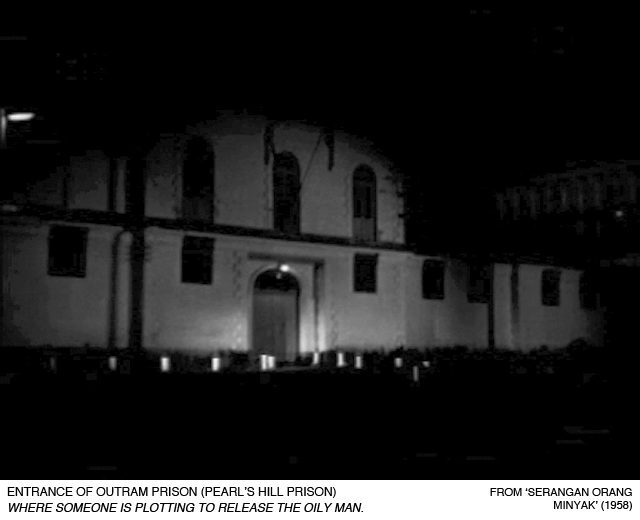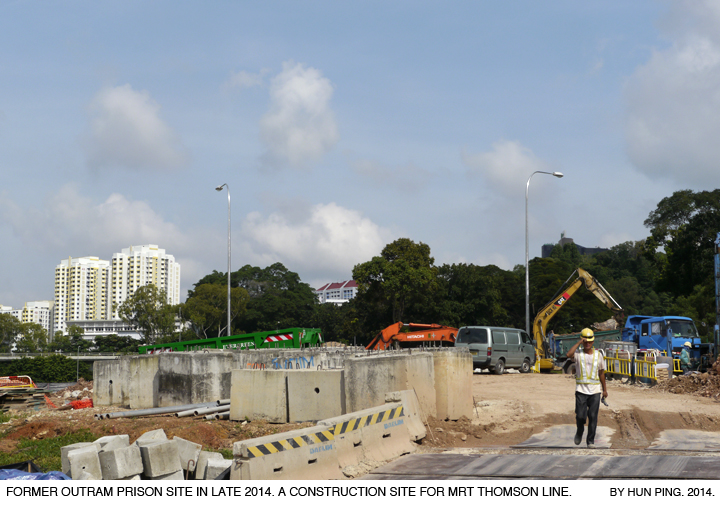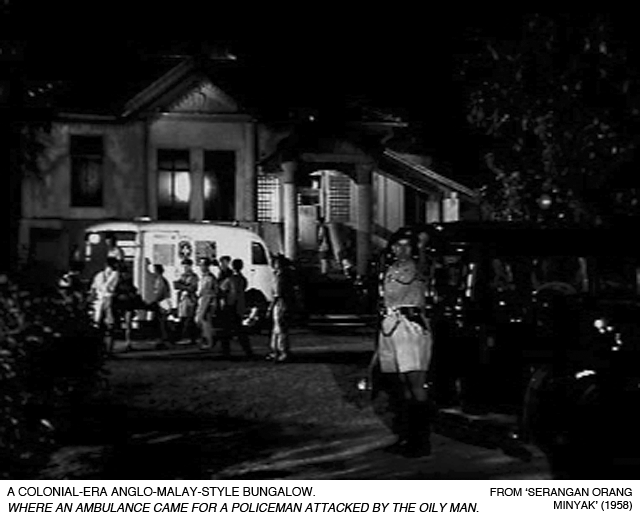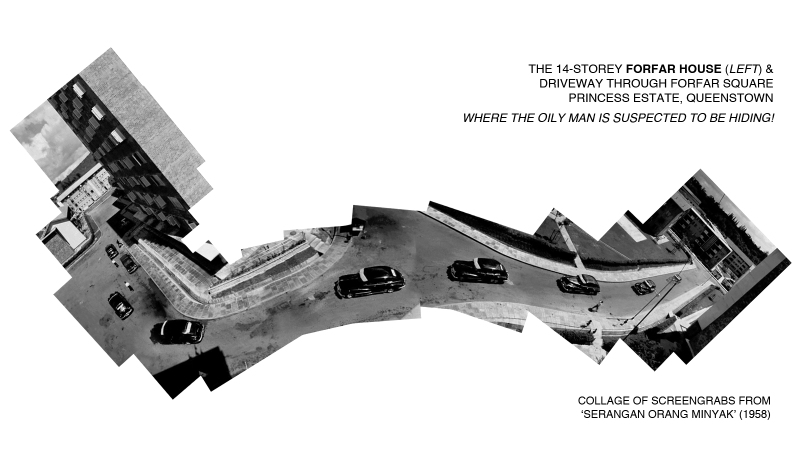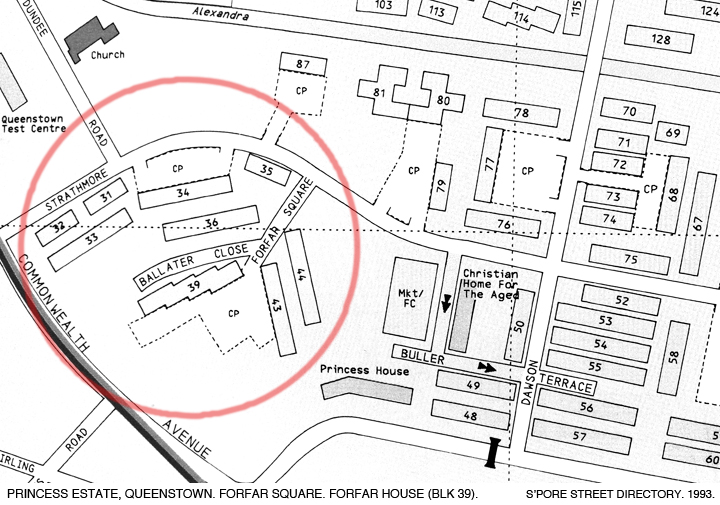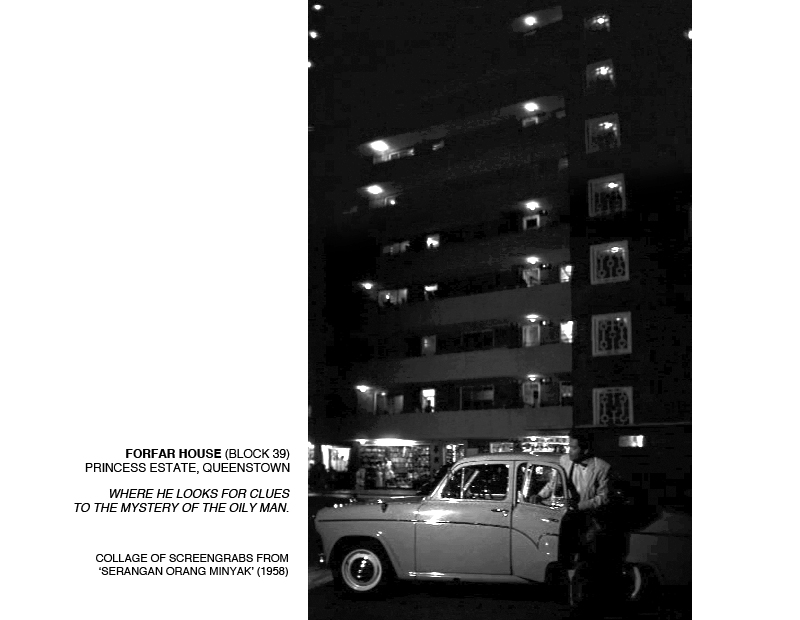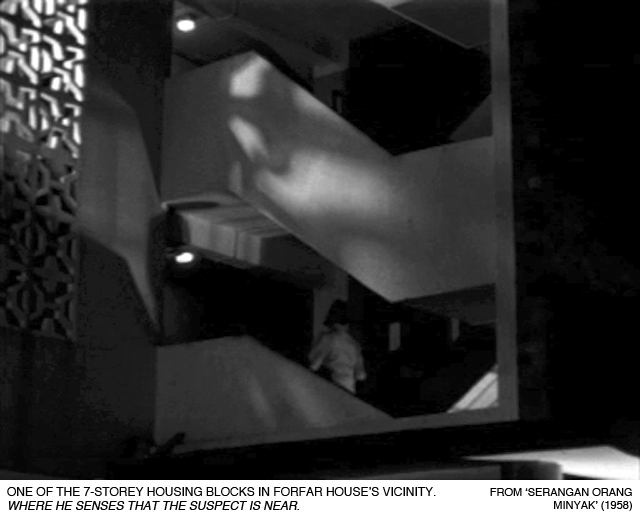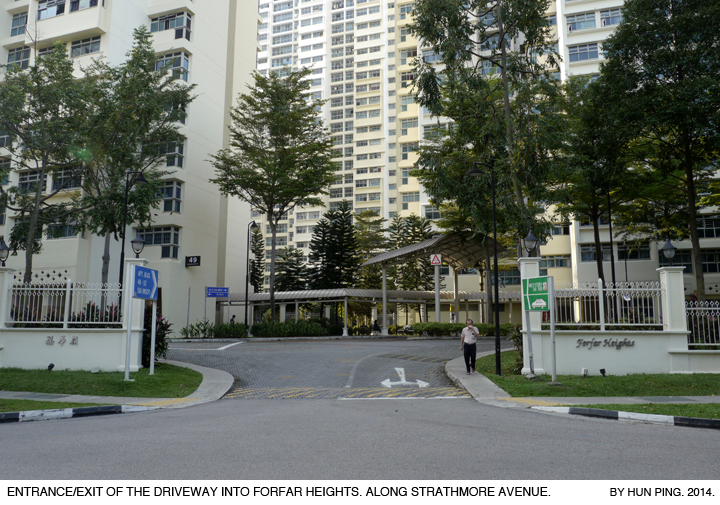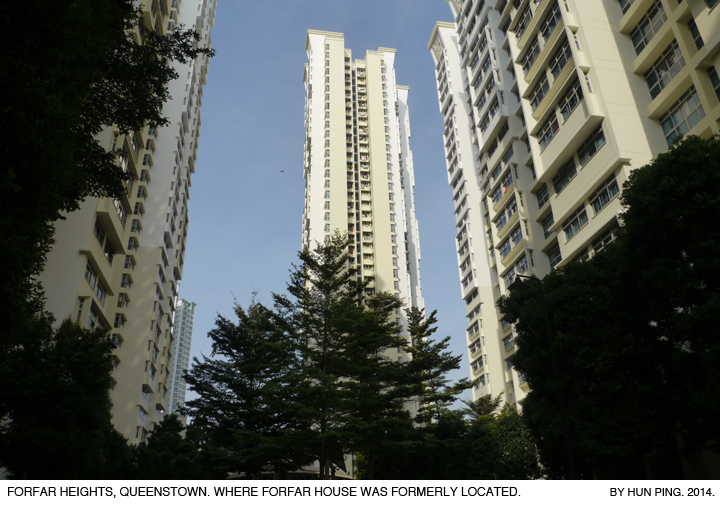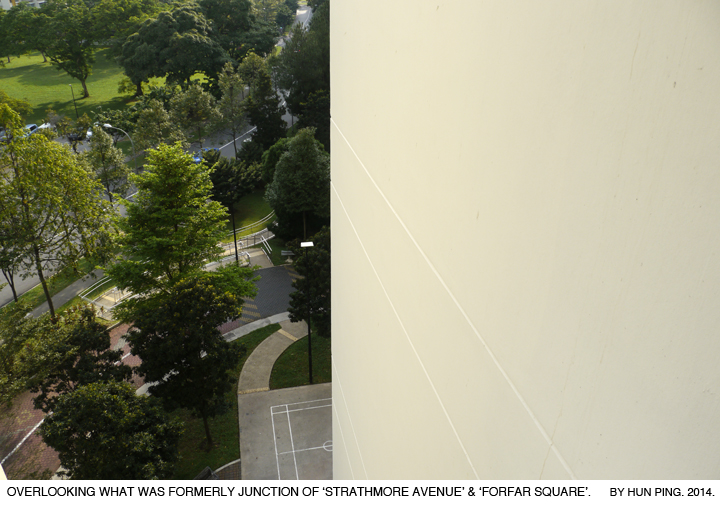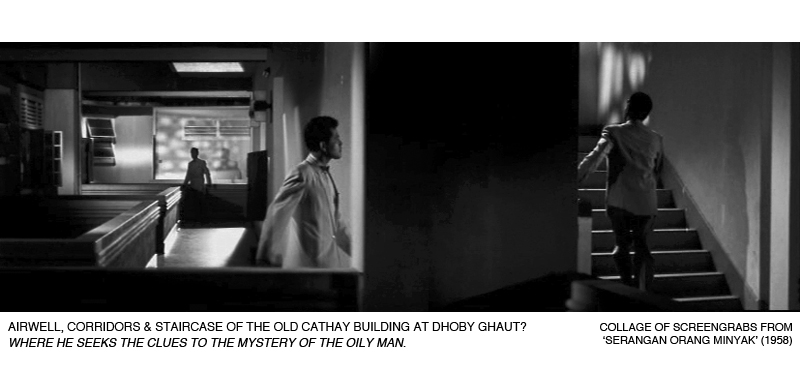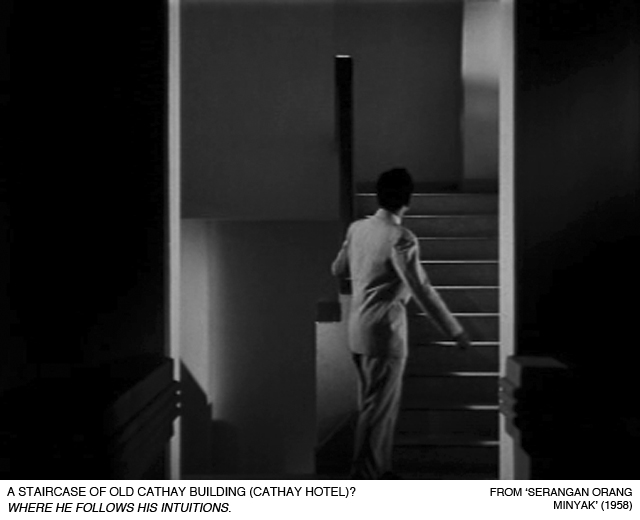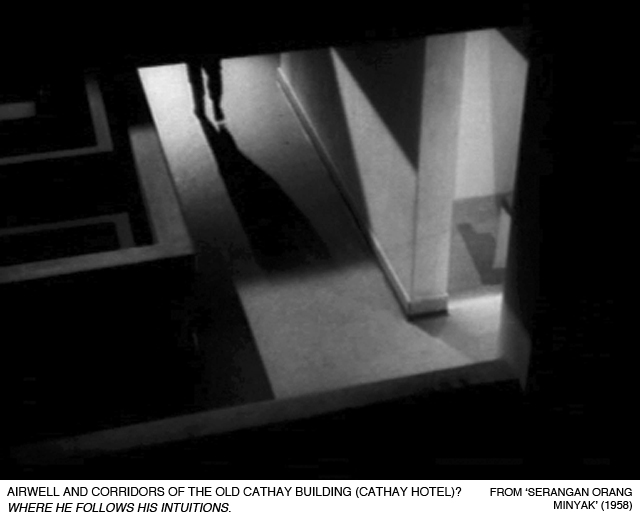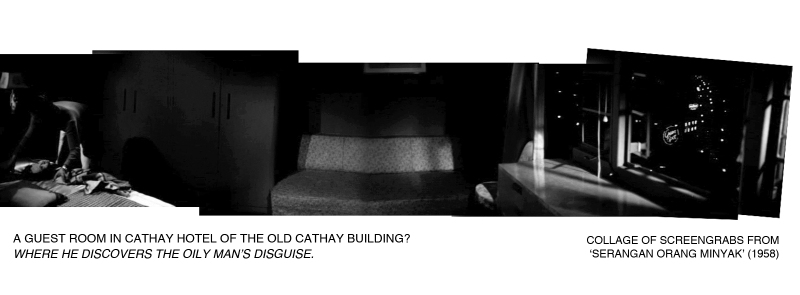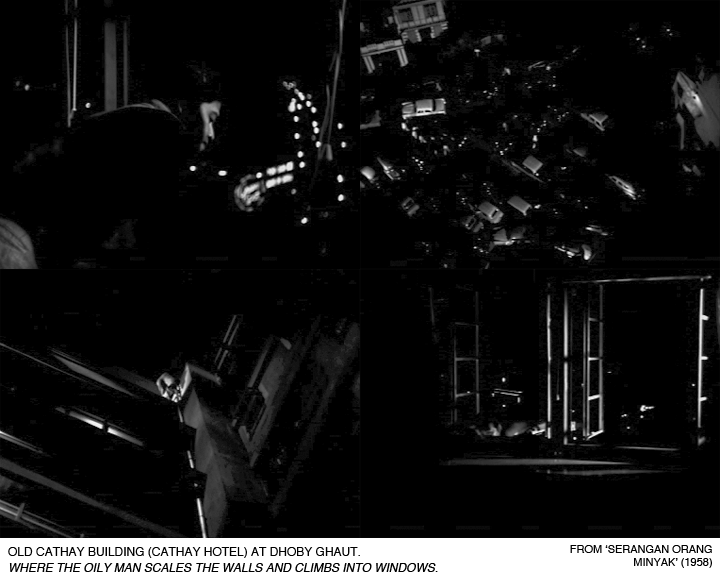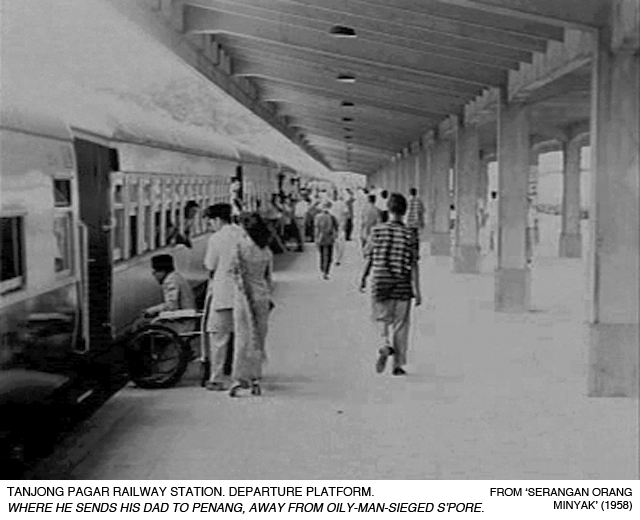Original film title in Malay: Serangan Orang Minyak
English title: The Oily Man Strikes Again
Directed by L. Krishnan
Written by L. Krishnan
Language: Malay
Starring: M. Amin, Nordin Ahmad, Latifah Omar
Produced by Cathay-Keris Films
Film Locations:
Outram Prison (or Pearl’s Hill Prison)
Forfar House and vicinity
Princess Estate, Singapore Improvement Trust flats (Queenstown)
Old Cathay Building at Dhoby Ghaut
A colonial-era Anglo-Malay style bungalow
Tanjong Pagar Railway Station
Ocean Park Hotel (East Coast Road)?
Office of Cathay-Keris Film Studios (532D, East Coast Road)
IN THE FINAL MONTHS OF 1957, certain parts of the city of Singapore were in a state of pandemonium. An ‘Oily Man’, whose last incarnated appearance caused widespread hysteria in 1954, was on the prowl again, this time terrorizing women in the residential estates of Clementi, Alexandra, Ayer Rajah and Changi. The first complaint about the ‘Oily Man’ – a serial molester who covered himself in a mixture of coconut oil and soot to elude capture – was made by a Malay corporal of the Light Aid Detachment in Clementi Estate; the soldier claimed that his wife was molested in her sleep by the oily man, who left greasy trails behind at the crime scene. Female Malay residents in the neighbourhood got paranoid over whether they would be the next victim and rushed to move out of the estate. A religious head (the Chief Kathi of Singapore) even declared after the incident that the supernatural oily man had transformed himself into a dog! Fear over the oily man spread to other parts of Singapore as more reports of molest cases and sightings of the demonic figure surfaced in the following weeks.
The exploits of the notorious ‘Oily Man’ captured the imagination of the local population and both of the major film studios in Singapore, Shaw Brothers’ Malay Film Productions and Cathay-Keris, were quick to latch on to the “craze”. By the end of 1957, they had set out to make ‘Orang Minyak’-inspired horror films with a fantastical slant (especially after the success of the ‘Pontianak‘ films). The directors – Malay Film Productions’ P. Ramlee and Cathay-Keris’ L. Krishnan – competed to come up with the first ‘Orang Minyak’ movie. L. Krishnan was quicker and titled his film Orang Minyak (released in February 1958), causing P. Ramlee, who took a longer time crafting his masterpiece, to rename his film Sumpah Orang Minyak (‘The Curse of the Oily Man’; released in April 1958).
This was a reversal of what happened with the ‘Pontianak’ film sequels, where Malay Film Productions beat the race to release Anak Pontianak (‘Son of Pontianak’; in February 1958), forcing Cathay-Keris to drop the plans for their own Anak Pontianak, change tack and release their Sumpah Pontianak at a later date in April 1958, during the Hari Raya season.
A review and synopsis of Orang Minyak in the Straits Times (14 February 1958) described: “… an elusive, ominous figure, covered in dripping black oil, he terrorizes kampongs and embarks on a trail of murder. Then the police lay a trap for him in a haunted house.” Hinging on Orang Minyak’s box-office success, L. Krishnan went on to make a sequel Serangan Orang Minyak (released in November 1958), which continued the story from the first installment. Which explains why Serangan Orang Minyak begins with a scene at the Outram Prison (Pearl’s Hill Prison) where the Oily Man character (Nordin Ahmad) is shown imprisoned, but makes an escape with the help of a flaming torch summoned by a talking banana tree.
The Oily Man is out to enact revenge on police inspector Dasuki (M. Amin) who plotted his arrest in the first Orang Minyak movie. He taunted Dasuki with phone threats and written warnings on slips of paper passed to him in a barbershop. Dasuki senses that his beautiful wife (Latifah Omar) is in danger, knowing that the Oily Man is a devilish serial rapist. He also sends his (incompetent) subordinates to guard his father’s house (a colonial era Anglo-Malay style bungalow; we are still wondering whose house it was, in reality, and where it was located).
Dasuki’s investigations into the escaped Oily Man’s whereabouts lead him to several locations across Singapore, both rural and urban. Most notable among them is the Forfar House (Block 39) in Princess Estate, Queenstown – a 14-storey Singapore Improvement Trust (SIT) housing novelty, in terms of both height and architecture. (It was the tallest residential development and sixth tallest building in Singapore when it opened in October 1956; it boasted of a distinctive zigzag curvilinear design that could withstand wind pressure, lift access to all occupants and a modern sanitary system with each unit having its own rubbish chute and running water tap. It was then the British-colony’s showpiece mass public housing architecture, but it later came to be better known as a choice spot for attempting suicide.)
Inspector Dasuki pays a visit to the Forfar House vicinity at night, scales the staircases (not of Forfar House actually, but of a neighbouring 7-storey block) and scrutinizes the common corridors (of the old Cathay Building, actually) in search of traces of the oily man.
Forfar House (Block 39) was chosen for the ‘Selective En-bloc Redevelopment’ (SERS) scheme in 1996, and its residents were moved out after being offered new replacement flats at Stirling Road. Forfar House and the other buildings in the original housing precinct were demolished to make way for the new Forfar Heights cluster.
The Cathay Hotel reception lobby and its guest rooms were also featured as the residence of the police inspector’s assistant superintendent (ASP).
Elsewhere in the film, Inspector Dasuki sends his father off at the Tanjong Pagar Railway Station and settles him in a ‘sanitorium’ in Penang (in reality, presumably the Ocean Park Hotel at East Coast Road). The inspector himself resides in a double-storey house that has an entrance that resembled the office of the Cathay-Keris film studio at 532D, East Coast Road.
Further Reading:
1. ‘2 sharikat membuat film ‘Orang Minyak’. Berita Harian. 30 January 1958, p. 2.
2. ‘Awas ‘Orang Minyak’ akan keluar’. Berita Harian. 31 January 1958, p. 7.
3. ‘Oily Man on the screen’. The Straits Times. 14 February 1958, p .10.
4. Amir Muhammad, 120 Malay Movies (pp. 130-132). Petaling Jaya: Matahari Books, 2010.
5. ‘Phantom: Big Hunt’. The Straits Times. 11 October 1957, p. 1.
6. ‘Terrified women flee from the oily phantom’. The Straits Times. 12 October 1957, p. 4.
7. ‘‘Oily Man’ wounded after assault on a Colony woman’. The Singapore Free Press. 25 October 1957, p. 1.
8. ‘Oily man again shocks a woman at night’. The Straits Times. 30 October 1957, p. 7.
9. ‘Changi airman gives oily man a belting’. The Straits Times. 10 November 1957, p. 5.
10. ‘Forfar House is the sixth highest’. The Straits Times. 4 November 1956, p. 5.
11. ‘Chemistry experts laid bare secret of S’pore ‘oily man’’. The Singapore Free Press. 10 September 1958, p. 3.
12. Queenstown. Singapore Infopedia. National Library Board, 2005.
13. Cathay Building. Singapore Infopedia. National Library Board, 2004.
Film Images:
© 1958 Cathay-Keris
© 2001 Music Valley
Digital Map Source:
Great Britain. Royal Air Force, Singapore photomap, National Library of Australia, MAP G8041.A4 s6 1950. [http://nla.gov.au/nla.map-vn502375]
Photographs:
© 2013, 2014 Toh Hun Ping


